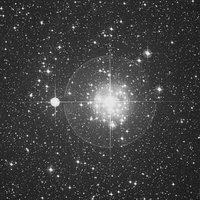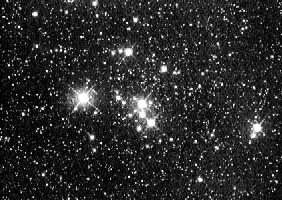
Originally discovered before 1654 by Giovanni Hodierna, this cluster has some nebulosity associated with it that I was unable to detect. It is estimated to be only 4-5 million years old and lies about 4800 light years away.
The cluster is easy to find, located near the hind legs of Canis Major. It contains a bright star near the center, which is visible to the naked eye. The other stars in the cluster are much fainter, and appear almost triangular in shape. Perhaps 15-20 stars are visible in all.
As a side note, I researched the cluster this morning and found out that Tau Canis Majoris is actually a multiple star system. I will need to revisit it and see if I can split any of the components.

Caroline Herschel, sister of famous astronomer William Herschel, discovered this cluster in 1783. She described it as "A beautiful cluster of pretty compressed stars near 1/2 degree in diameter." Her notes were overlooked until her brother included the cluster in his 1786 catalogue and acknowledged her as the discoverer.
The best view of this is at 203x. The stars appear as several small chains of 3-5 stars in short arcs, giving the appearance of a pinwheel. The center of the cluster have dimmer stars that are difficult to resolve without averted vision. All in all, there are about 30-40 stars visible, making for a fantastic cluster. Thanks, Caroline!

This cluster was also originally discovered by Giovanni Hodierna before 1654, and independently rediscovered by Charles Messier on February 19, 1771. (Maybe we should make an observing list of the Hodierna catalog?) However, because Messier inadvertently reversed the signs on his coordinates in his catalog, it was considered "lost." In 1959, Canadian astronomer T.F. Morris realized that if he reversed the signs on the Messier coordinates, it corresponded to NGC 2422. Thanks to his insight, we can now complete our Messier certificates!
This is a big open cluster, nearly filling the field of view at 49x. It contains several very bright stars in a loose pattern, somewhat reminding me of the overall shape of the United States. One bright star at the edge represents Maine, another bright star at the Texas/Mexico border, some faint stars filling out Florida and California, and a nice tight double somewhere in Missouri. Overall, a great cluster.

M46 is a bit farther away than nearby M47, at a distance of about 5500 light years. On February 19, 1771, Charles Messier catalogued it with the following description: "A cluster of very small stars, between the head of the Great Dog and the two hind feet of the Unicorn, [its position] determined by comparing this cluster with the star 2 Navis, of 6th-magnitude, according to Flamsteed; one cannot see these stars but with a good refractor; the cluster contains a bit of nebulosity."
Since this entry did not get published right away, Caroline Herschel also independently discovered it in March, 1783. Three years later, her brother William would discover the planetary nebula within it.
My own observation of the cluster was as follows: At 49x, it has a nearly globular appearance, with bright stars randomly interspersed. At 81x, it fills the field of view and many more stars can be detected. Using 121x, I could see the faint nebulosity of the planetary nebula NGC 2438 near the edge of the cluster.

Forty seven years after his father William discovered it, John Herschel described NGC 2438: "The brightest part of a very fine rich cluster; stars of 10th magnitude; which fills the field. Within the cluster at its northern edge is a fine planetary nebula."
Buried within the edges of M46, this planetary is a large, faint gem. At 203x, it appeared ringlike, bright at the edges and dark or transparent at the center. Combined with a large open cluster (M46) in the same field, this was a special treat.